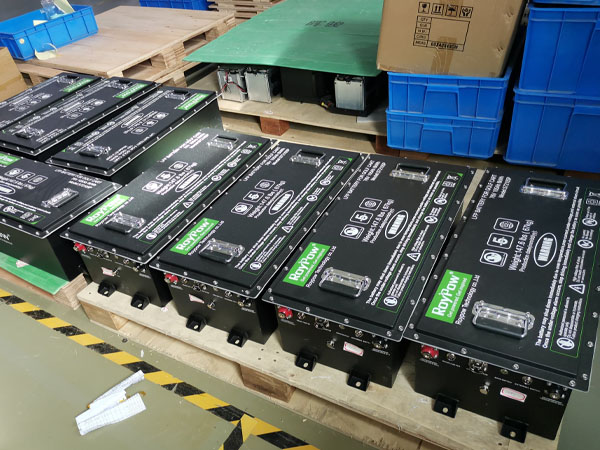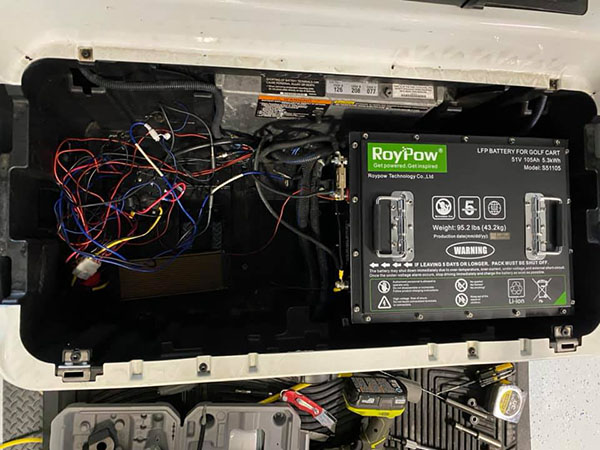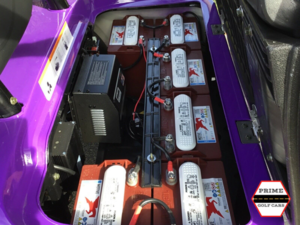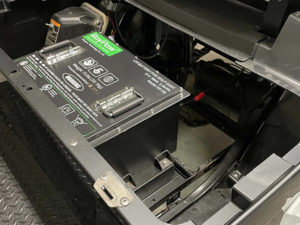Jupiter Golf Cart Rentals is in the business of selling lithium golf cart batteries, most notably Roy Pow lithium batteries. With our turn-key replacement system, anyone can easily convert their golf cart from the standard lead-acid batteries to lithium batteries in less than an hour. Switching to lithium batteries comes with several benefits, and can take you and your golf cart to distances far beyond where it could go before, and then further.

Why choose lithium?
Lithium batteries are slowly beginning to enter the mainstream world of golf carts – they are universal and can be installed in any golf cart. At Jupiter Golf Cart Rentals, not only do we offer Roy Pow lithium batteries, but for a nominal fee, we can install it and easily convert a lead-acid battery system in less than an hour. Roy Pow batteries also come with a 5-year warranty.
When buying a lithium battery, the price is higher than a regular lead-acid battery, but the benefits far outweigh the cost. For one, once that lithium battery is installed, it won’t need to be replaced for up to 10 years – up to 70% in expenditures can be saved over a 5 year period, since it won’t need to be continuously replaced like a lead-acid battery. Roy Pow lithium batteries have a quick charge time of approximately 2.5 hours, and can be rapidly charged to about 80% in only an hour. It takes up to five hours to charge the battery completely, and once fully charged, it will hold that charge for about 8 months when not in use. – they also have a life cycle of up to 3,500 charge cycles. The distance a golf cart can travel depends on the power level of the lithium battery, measured in amp hours (A/H):
56 A/H: 30-35 miles per charge.
105 A/H: 60-65 miles per charge.
160 A/H: 95-100 miles per charge.
Lithium batteries are also much better for the environment, since they aren’t made with harmful chemicals like lead-acid batteries and give off no dangerous fumes. Since they aren’t filled with water either, they don’t need to be maintained like lead-acid batteries, and are considered maintenance free. Roy Pow lithium batteries are much lighter as well – since multiple lead-acid batteries are used to power a cart, the weight increases vastly, but only one lithium battery is needed, and depending on the level of power, can weigh less than 100 pounds. This puts less stress on the golf cart, and allows it to carry more weight and reach higher speeds with less effort. A Roy Pow lithium battery also has multiple built-in safety measures, such as fire detection systems, water spray systems, flammable volatile monitoring and alarms, battery box warnings and protections, battery operating situation monitoring, and anti-collision, along with many other active safety systems. They have systems that prevent them from overcharging, over discharging, short-circuiting, overheating, and even have anti-theft systems and remote GPS tracking, with the ability to check the battery status remotely in real time.
To power a golf cart, 6 or 8 lead-acid batteries are needed. Only one lithium battery is needed to power this whole cart.
Why switch from lead-acid batteries?
Lead-acid batteries are the standard in almost every golf cart, most of the time being flooded lead-acid. These batteries need to be regularly filled with water, and also contain multiple chemicals and gases, including sulfuric acid and lead compounds. Not only are these batteries filled with a multitude of harmful chemicals, they have a possibility of giving off potentially dangerous fumes when plugged in to charge, and can even explode if something goes wrong during charging. The water inside also makes them very heavy, and with 6 or 8 in a golf cart, a lead-acid battery system can add over 300 pounds of weight to a golf cart. When plugging in a golf cart with lead-acid batteries, it’s very important to remember to lift up the seat to ventilate the fumes that may come off the battery, as buildup under the seat can be extremely dangerous. Cart owners with lead-acid battery carts must regularly perform maintenance on them, like waterfilling and terminal tightening, as well as cleaning potentially harmful acid deposits. Lead-acid batteries will also only last a few years at most, with a life cycle of about 500 charges. They need to be charged every day as well, and can take about 12 hours to fully charge. In short, lead-acid batteries do have their benefits and are easy to find, but don’t last long, and need to be replaced often – replacing them also comes with the cost of having them installed.
If you’re interested in switching from lead-acid to lithium batteries, or just want more information, you can visit our lithium battery site to view the various types of lithium batteries available and contact us using the phone number or contact form.


